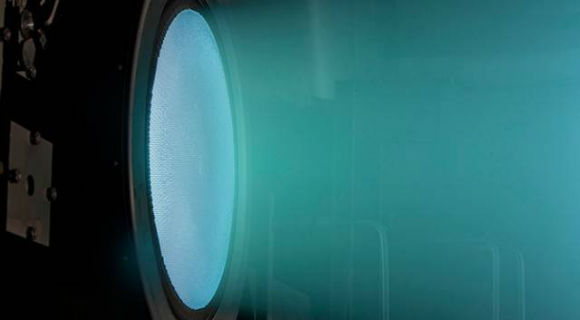When a current passes between
two electrodes — one thinner than the other — it creates a wind in the air
between. If enough voltage is applied, the resulting wind can produce a thrust
without the help of motors or fuel. This phenomenon, called electrohydrodynamic thrust (or, more
colloquially, “ionic wind”) was first identified in the 1960s. Since then,
ionic wind has largely been limited to science-fair projects and basement
experiments; hobbyists have posted hundreds of how-to videos on building
“ionocrafts” (lightweight vehicles made of balsa wood, aluminum foil and wire)
that lift off and hover with increased voltage.
Despite this wealth of
hobbyist information, there have been few rigorous studies of ionic wind as a
viable propulsion system. Some researchers have theorized that ionic thrusters,
if used as jet propulsion, would be extremely inefficient, requiring massive
amounts of electricity to produce enough thrust to propel a vehicle. Now
researchers at MIT have run their own experiments and found that ionic
thrusters may be a far more efficient source of propulsion than conventional
jet engines. In their experiments, they found that ionic wind can produce as
high as 100 newtons of thrust per kilowatt (100 N/kW), compared with a jet
engine’s 2 newtons per kilowatt (2 N/kW). [1] That as you understand is a
massive improvement in efficiency and performance, well as to power capacity
and availability, opening new horizons for applications that may as well exceed
those of airplane propulsion.The team has published its results in the
Proceedings of the Royal Society. Read the abstract here.
A basic ionic thruster
consists of three parts: a very thin copper electrode, called an emitter; a
thicker tube of aluminum, known as a collector; and the air gap in between. A
lightweight frame typically supports the wires, which connect to an electrical
power source. As voltage is applied, the field gradient strips away electrons
from nearby air molecules. These newly ionized molecules are strongly repelled
by the corona wire, and strongly attracted to the collector. As this cloud of
ions moves toward the collector, it collides with surrounding neutral air
molecules, pushing them along and creating a wind, or thrust.
There is one big obstacle to
ionic wind propulsion : thrust density, or the amount of thrust produced per
given area. Ionic thrusters depend on the wind produced between electrodes; the
larger the space between electrodes, the stronger the thrust produced. That
means lifting a small aircraft and its electrical power supply would require a
very large air gap. Another drawback is the voltage needed to get a vehicle off
the ground. Small, lightweight balsa models require several kilovolts. Hence a
small craft, with onboard instrumentation and a power supply, is estimated that
it would require hundreds or thousands of kilovolts.
On the other hand, the
propulsion of choice for science fiction writers has become the propulsion of
choice for scientists and engineers at NASA. The NASA Glenn Research
Center has been the lead for electric propulsion since work on ion
propulsion began there in the 1950s. The ion propulsion system's efficient use
of fuel and electrical power enable modern spacecraft to travel farther,
faster, and cheaper than any other propulsion technology currently available.
Ion thrusters are currently used for stationkeeping on communication satellites
and for main propulsion on deep space probes. Ion thrusters, are somewhat
different to Ionic Wind Thrusters, although they too expel ions to create
thrust and can provide higher spacecraft top speeds than any other rocket
currently available. The Dawn Mission
is one of those examples.
Modern ion thrusters use
inert gases for propellant. The majority of thrusters use xenon, which is
chemically inert, colorless, odorless, and tasteless. The propellant is
injected from the downstream end of the thruster and flows toward the upstream
end. This injection method is preferred because it increases the time that the
propellant remains in the chamber. In an ion thruster, ions are accelerated by
electrostatic forces. The electric fields used for acceleration are generated
by electrodes positioned at the downstream end of the thruster. Each set of
electrodes, called ion optics or grids, contains thousands of coaxial
apertures. The stream of all the ion jets together is called the ion beam. The
thrust force is the force that exists between the upstream ions and the
accelerator grid. The exhaust velocity of the ions in the beam is based on the
voltage applied to the optics. [2]
The downside of ion
thrusters, though, is that the amount of thrust produced is minuscule:
State-of-the-art ion thrusters can deliver a grand total of 0.5 newtons of
thrust (equivalent to the force of a few coins pushing down on your hand),
while chemical thrusters (which power just about every spacecraft ever
launched) on a satellite or probe deliver hundreds or thousands of newtons. The
flip side of this, though (and the reason ion thrusters are so interesting) is
that they have a fuel efficiency that’s 10 to 12 times greater than chemical
thrusters. Obviously, for long trips through space, fuel efficiency is very
important.
However, with such puny
thrust, a most current NEXT-based ion drive would need to run for 10,000 hours
(just over a year) to reach a suitable speed for space travel. Dawn, a NASA
probe that’s powered by previous-generation NSTAR ion thrusters, accelerated
from 0 to 60 mph in four days. As a corollary, ion thrusters only work at all
because of the near-vacuum of space; if there was any friction at all, like
here on Earth, an ion drive would be useless. The good news, though, is that
the (eventual) max speed of a spacecraft propelled by an ion drive is in the
region of 200,000 miles per hour (321,000 kph). [3]
Further read :










+logo-w200.png)


No comments:
Post a Comment
Note: Only a member of this blog may post a comment.